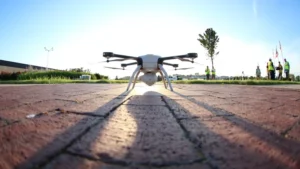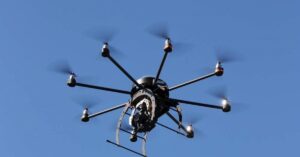Potential for Drone-based Inspection Services
Drones, also known as unmanned aerial vehicles (UAVs), have been gaining significant attention in recent years, and for a good reason. The potential for drone-based inspection services is vast and varied, and its use has seen growth in several industries, including construction, agriculture, and energy. With advancements in technology, drones have become more efficient, reliable, and affordable, making them an attractive option for businesses that require regular inspections.

One industry that stands to benefit significantly from drone-based inspection services is the construction industry. The use of drones in construction has been increasing in popularity over the last few years, with drones being used for site surveys, progress reports, and project management. Drones equipped with high-resolution cameras can provide construction managers with real-time footage of construction sites, allowing them to identify and address issues quickly. Drones can also be used to inspect hard-to-reach areas, such as roofs and tall buildings, which can be dangerous for workers to access.
In the agriculture industry, drones are being used to help farmers monitor their crops. By using multispectral cameras, drones can capture images of crops in different spectrums of light, which can help identify areas of the crop that may require attention. For example, drones can detect areas of crops that are under stress due to lack of water or nutrients, allowing farmers to address these issues before they become more significant problems.
Another industry that can benefit from drone-based inspection services is the energy sector. Drones equipped with thermal imaging cameras can be used to inspect power lines and wind turbines, identifying areas of concern such as overheating or damage. Drones can also be used to inspect oil and gas pipelines, identifying leaks or areas that require repair. Using drones for these types of inspections can significantly reduce the time and cost associated with traditional inspection methods.
Advantages
One of the main advantages of using drone-based inspection services is the speed and efficiency that it offers. Traditional inspection methods can be time-consuming and often require a significant amount of manpower. Drones can cover large areas quickly and can provide detailed information in a fraction of the time that it would take using traditional methods. Additionally, using drones for inspections can significantly reduce the risks associated with human inspection, particularly in hazardous or hard-to-reach areas.
Another advantage of using drone-based inspection services is the cost savings that it can provide. Traditional inspection methods can be expensive, particularly when it comes to accessing hard-to-reach areas. Using drones can significantly reduce these costs, as there is no need for specialized equipment or personnel to access these areas. Additionally, using drones for inspections can reduce the need for scaffolding or other equipment, which can also lead to significant cost savings.
However, there are also some challenges that need to be addressed before drone-based inspection services can be widely adopted. One of the main challenges is regulatory compliance. Drones are subject to regulations from aviation authorities, and it can be challenging to navigate these regulations. There are also concerns around privacy and security, particularly when it comes to the use of drones for surveillance.

Another challenge is the need for skilled personnel to operate drones and interpret the data they collect. While drones are becoming more user-friendly, there is still a need for skilled operators who can navigate the technology and collect accurate data. Additionally, there is a need for trained professionals who can interpret the data collected by drones, particularly in industries such as agriculture, where the data can be complex.
One area where we are likely to see significant growth in the use of drone-based inspection services is in the use of artificial intelligence (AI) and machine learning. AI-powered drones can be used to collect and analyze data, identifying patterns and anomalies that may not be apparent to human operators. For example, drones equipped with AI technology can be used to inspect infrastructure such as bridges or buildings, analyzing data in real-time to identify areas of concern.
Another area where we are likely to see growth is in the use of autonomous drones. Autonomous drones can be programmed to fly pre-determined routes and collect data, reducing the need for skilled personnel to operate the drones. This technology is already being used in the agriculture industry, where autonomous drones can be used to survey crops and identify areas that require attention.
The potential for drone-based inspection services is vast, and as technology continues to advance, we are likely to see new applications and use cases emerge. However, it is essential to address the challenges associated with the use of drones, such as regulatory compliance and the need for skilled personnel. By doing so, we can unlock the full potential of drone-based inspection services, improving efficiency, reducing costs, and enhancing safety in a wide range of industries.
Furthermore, the use of drone-based inspection services can also help businesses reduce their environmental footprint. Traditional inspection methods often require the use of heavy equipment or vehicles, which can have a significant impact on the environment. By using drones, businesses can reduce their carbon footprint and improve their sustainability efforts.
Another benefit of using drone-based inspection services is the increased accuracy of the data collected. Drones equipped with high-resolution cameras or sensors can capture data in greater detail than traditional inspection methods, leading to more accurate assessments and decision-making. This level of accuracy can be particularly beneficial in industries such as construction or energy, where small issues can have significant impacts.
The use of drone-based inspection services can also help businesses reduce downtime and increase productivity. Traditional inspection methods often require businesses to shut down operations temporarily, leading to lost productivity and revenue. By using drones, businesses can continue operations while inspections are being carried out, leading to minimal disruption and increased productivity.
In summary, the potential for drone-based inspection services is vast and varied, and its use is increasing in several industries. The speed, efficiency, and cost savings that drones offer make them an attractive option for businesses that require regular inspections. While there are challenges that need to be addressed, the benefits that drone-based inspection services offer are clear. As technology continues to advance, we are likely to see more businesses adopting drone-based inspection services, leading to improved efficiency, reduced costs, and enhanced safety in a wide range of industries.









